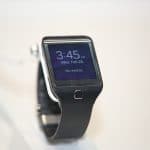A guide to this series:
Part 1 covers planning and budgeting – campaign goals and budget, campaign timeline, list selection
Parts 2 & 3 cover development of the direct mail piece – the offer, form factor, headline, and price plus persuasive copy and design.
Part 4 covers follow-on marketing and evaluation of campaign results.
1) What form factor should we choose?
Oversized postcards and half-fold self-mailers are usually the best value for corporate wellness providers, wellness centers, health clubs, yoga studios and other wellness businesses. The half-fold’s larger size helps it stand out from other direct mail pieces.
Avoid: tri-fold/letter-fold, z-fold and double-parallel fold using 8.5″ x 11″ paper. They’re roughly the size of a #10 business envelope, which means they don’t stand out.
If you do choose these folds, go with a larger paper size so that your final piece will be larger: 8.5″ x 14″, 11″ x 17″, or even 11″ x 25.5″. You’ll pay significantly more, though.
The right-angle-half fold works well if you have lots of content – for example, a multi-day program or conference. But it requires impeccable content and layout to avoid overloading your reader. (And overloaded readers just pitch your mailer – they don’t try to decipher it.)
Don’t bother sending small postcards – they don’t demand attention.
And avoid long-form sales letters inside envelopes unless you sell via mail order exclusively. They usually squander the greatest asset that wellness businesses have: their local presence.
And naturally, avoid mass mailings of general-purpose brochures that lack a strong call to action. A generic “capabilities brochure” mailing for a corporate wellness provider rarely generates a response, for example.
2) What’s the best way to ask for the sale?
In direct mail, the best way to make the sales is NOT to ask for it in your initial mailing.
Why?
Well, most direct mail campaigns target potential customers who have never heard of your business, much less called or visited.
If you’re mailing people who have never heard of you before, you’re kidding yourself if you think a postcard can persuade them to go ahead and pay you hundreds of dollars for a sports conditioning program or healthy weight program.
So your goal should usually be to generate leads that will eventually lead to a sale, rather than expecting an immediate sale as soon as they receive your mailing.
Instead of asking them to buy – which is premature and presumptous – ask them to RESPOND..to engage with your business in a totally non-threatening way. Then, once they contact you, your follow-up marketing kicks into gear to start moving them through the rest of the sales process as appropriate.
You might ask them to:
- call for a free fitness consultation
- register for a free healthy kids seminar
- download a nutrition checklist
- call for a report on corporate wellness
- download a fitness or exercise log
- schedule a no-pressure tour of your facility
- attend a fun event like an open house
- attend a free seminar or lunch-and-learn on a new health development
- attend a panel of local notables
You can further reduce risk with terms like “no obligation” and “no hassle”.
You can heighten interest with terms like “announcing” or “at last” or “new.”
And you can accelerate the response by adding urgency with terms like “limited time only” or emphasizing a deadline.
On the other hand, if you target prior or existing customers, a purchase may be a perfectly realistic next step.
3) What pitfalls should we watch for when we develop our offer?
Your potential client or member will only respond if the benefits of responding appear likely to outweigh the costs and risks.
Your customer sees lots of costs and risks that your marketing team’s not even thinking about, like:
- how they’ll find time to respond
- the nervous feeling that accompanies doing anything new for the first time (even a tour!)
- deciding what to say when they first call or walk in
- feeling like an idiot or out of place
- worrying about parking
- not liking your staff or your business
- anxieties about possible harm or injury or discomfort from your program
- discovering that what you offer is different from what they expected
- trying to figure out if what you have is useful for them
- having to figure out where you’re located
- worrying about what you may ask them
- anxiety about whether they’ll be pressured to buy or do something
- wasted time and gas
- deciding what to wear
As a result, offers succeed only when they 1) offer something of great value and 2) overcome these risks and costs.
They fail when they don’t offer enough value to offset the perceived risks and costs.
Two examples:
A 10 – 15% discount is trivial, especially compared to the list of risks and costs above. It doesn’t offer enough value to make it worth rolling the dice. A 10% discount on chiropractic services isn’t enough to incent people who have heard stories from friends about less-than-satisfactory experiences, or somehow think that chiropractic is “less respectable” than say, a physical therapy visit.
A free tour of a health club doesn’t offer much value to potential customers. It’s mostly of value to YOU, because you hope they’ll buy. Boost the value of the tour by adding elements like a mini- health assessment, free class coupons, invitations to free seminars and the like.
The key point: successful direct mail offers remove all risk from the next step, and leave potential customers thinking “Gosh, I’d be nuts not to do this!”
4) Where should we put the call to action?
Put your call to action in several places, not just one – in a large, easy to read font.
Remember: If you’re using a postcard, you need words on the front (the non-address side) that motivate people to flip it over to to see the other side.
This means you need text – content! – on the front, not just a big pretty picture.
Trust us, 9 times out of 10 times a picture alone is not so interesting they’ll turn it over. We’ve seen a lot of failed postcard mailings for yoga studios that featured frighteningly calm women looking at sunsets.
This message may not be the same as your actual offer. For example, on the front non-address side you might use a leading question like “Did you know that you….” and then finish the question on the flip side as a segue to your main content.
5) Should we include the price?
What’s most important is what you say BEFORE you talk about price.
Price doesn’t mean anything until people know what they’re getting in exchange.
Choose carefully engineered words to explain:
- what benefit they’ll get from your business
- how your business will make their life better what you’re actually offering
Then, and only then, should you mention price. “Free” is always compelling. If you’re simply generating leads, the best offers at this point in the sales process are free.
If you’re selling to existing customers, you have options. You can maintain price integrity but include lots of extras and bonus items or services to boost the perceived value of your offer. Or you can offer serious discounts to those who respond – for example, 30% or BOGO (buy one/get one free).
(And a note about price – lower isn’t always better. Excellent content that strongly communicates the value of your services can easily support a higher price. And some wellness services even sell better when they’re priced higher.)




